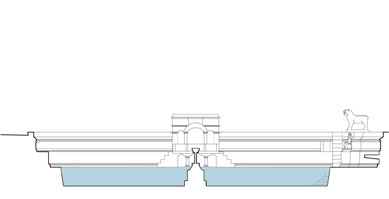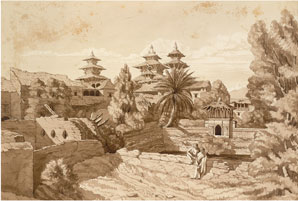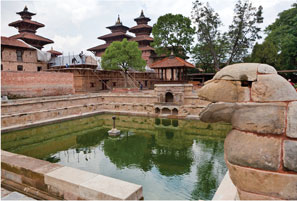BHANDARKHAL TANK
RESTORATION: APRIL 2008 - NOVEMBER 2010
FUNDED BY:
THE GOVERNMENT OF THE FEDERAL REPUBLIC OF GERMANY
US AMBASSADORS FUND FOR CULTURAL PRESERVATION
KVPT PRIVATE DONATIONS
The Bhandarkhal water tank is the focal element of the garden behind Patan Darbar. Both the tank and the nearby Tusha Hiti are connected to Patan's historic water infrastructure, which includes 5 aquifers, 11 reservoirs, 28 drinking water fountains, and 34 step-wells. The Lohan Hiti water spout on the east side of the tank was once the main source of water for Patan Darbar. Prior to restoration, the tank was in a structurally unstable condition and lacked foundations. Monsoon rains would drain into the ground within hours, indicating the failure of the traditional black clay waterproofing system. During the recent restoration, new brick foundations and retaining walls were built, a pond liner was added to prevent water leakage, and the surviving stone carvings were saved and reinstalled.
Severely damaged stones were replaced with new stones of matching texture and color. Nepali craftsmen worked with stone conservators from the University of Applied Arts Vienna to restore the carved stone elements. Surviving 19th century views of the tank provided sufficient documentation for the reconstruction of the meditation pavilion, which had been poorly repaired after the 1934 earthquake with cement mortar and concrete balustrades. The 17th-century terracotta water channel was reset, allowing water to flow into the tank through the Lohan Hiti water spout.


